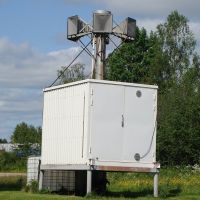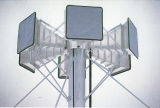Jyri
| UOO Jyri | |

| |
| Company | University of Oulu |
|---|---|
| Produced | 1990s-2000s? |
| Type | Supercharged Omnidirectional Electromechanical |
| Sound output | 68 dB @ an unknown distance |
| Voltage | 24 V DC |
The Jyri[1] is a supercharged electromechanical siren that was produced by the University of Oulu in Finland and was licensed to several Finnish companies during the early 1990's to presumably the early 2000's. Little to no documentation on these sirens is available and not many are known to exist, making these sirens quite elusive.
History
The Jyri was conceived by the University of Oulu sometime in the early 1990s. The exact year is unknown, though 1991 would be probable, as judging by a post on luftschutzsirene.de from 2011, the siren was around 20 years old by then.[2] During the siren's development, efforts were made to ensure that the siren would be effective in a variety of conditions, according to the siren's product sheet.[3] The Jyri was licensed to other Finnish companies during its lifespan, though exactly which companies are unknown. No other information can be found on the history of the Jyri, and it can be assumed that it was discontinued sometime in the early 2000s, with only a handful of units being sold throughout Finland.
Design

The Jyri is an interesting siren in terms of design. The siren uses compressed air which is obtained by means of an internal combustion engine housed within a thermally insulated container alongside with some of the siren's other components, with the container is held up by four legs. Air is forced up through the intake and into the siren's 6 port chopper, creating the siren's sound, which is amplified through its exponential horns which appear to be made of fiberglass, though this is unconfirmed. There are several supports above and below the horns, which hold their weight.
The siren also comes with a 24 V DC motor located at the top of the siren, which allows the siren to run without the combustion engine, though it is much quieter when doing so. The motor is housed in a cylindrical enclosure on top of the siren. Both of these seem to run when the siren is activated, but when it is turned off, the motor also shuts off, leaving the siren to be powered by the combustion engine, which's operating speed gets slower every 2 seconds or so, leading to the siren slowly winding down in increments. The Jyri is programmed to perform a silent test daily. About 90% of the siren is composed of Finnish parts, with the other 10% being imported. The head of the siren is about 2.5 m (8.2 ft) tall, 2.2 m (7.2 ft) wide, and 2.5 m (8.2 ft) long, with the entire assembly weighing about 1200 kg (2645 lbs). The Jyri is rated at 68 dB at an unknown range, but it is presumably greater than 100 ft.[3]
References
- ↑ While "Jyri" is often written in all caps, the product sheet refers to it as how it is written in this article.
- ↑ New foreign HLS type? - Luftschutzsirene.de
- ↑ Jump up to: 3.0 3.1 Jyri product sheet